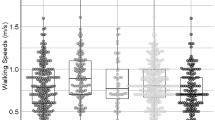Abstract
This paper proposes a framework for the visualization of crowd walking synchronization on footbridges. The bridge is modeled as a mass-spring system, which is a weakly damped and driven harmonic oscillator. Both the bridge and the pedestrians walking on the bridge are affected by the movement of each other. The crowd acts according to local behavioral rules. Each pedestrian is provided with a kinematic walking system. We extend a current mathematical model of crowd synchronization on footbridges to include human walking model and crowd simulation techniques. We run experiments to evaluate the influence of these extensions on synchronization.
Graphical Abstract







Similar content being viewed by others
References
Ashida K, Lee S, Allbeck J, Sun H, Badler N, Metaxas D (2001) Pedestrians: creating agent behaviors through statistical analysis of observation data. In: Proceedings of IEEE conference on computer animation, pp 84–92
Blue V, Adler J (2000) Cellular automata model of emergent collective bi-directional pedestrian dynamics. In: Proceedings of artificial life VII, pp 437–445
Bruderlin A, Calvert T (1989) Goal-directed, dynamic animation of human walking. In: Proceedings of ACM SIGGRAPH, pp 233–242
Caprioli A, Reynolds P, Vanali M, Zappa E (2006) Comparison of the effects of a moving crowd on different grandstands during similar events. In: 24th International modal analysis conference (IMAC XXIV)
Chen Sl (2003) Animating human walking. Available at http://www.ugcs.caltech.edu/shang/cs174/walking_report.pdf. Accessed April 2009
Dallard P, Fitzpatrick T, Flint A, Low A, Smith RR, Willford M, Roche M (2001) London millennium bridge: pedestrian-induced lateral vibration. J Bridge Eng 6(6):412–417
Eckhardt B, Ott E, McRobie A (2007) Modeling walker synchronization on the millennium bridge. Phys Rev E 75(2):021110
Farenc N, Musse SR, Schweiss E (2000) A paradigm for controlling virtual humans in urban environment simulations. Appl Artif Intell 14:69–91
Funge J, Tu X, Terzopoulos D (1999) Cognitive modeling: knowledge, reasoning and planning for intelligent characters. ACM Comp Graph (Proceedings of SIGGRAPH’99), pp 29–38
Hauksson F (2005) Dynamic behaviour of footbridges subjected to pedestrian-induced vibrations. Master’s thesis, Lund University, Sweden
Helbing D, Farkas I, Vicsek T (2000) Simulating dynamical features of escape panic. Nature 407:487–480
Hodgins JK, Wooten WL, Brogan DC, O’Brien JF (1995) Animating human athletes. In: Proceedings of ACM SIGGRAPH, pp 71–78
Ko H, Badler NI (1996) Animating human locomotion with inverse dynamics. IEEE Comput Graph Appl 16(2):50–59
Multon F, France L, Cani-Gasguel P, Debunne G (1999) Computer animation of human walking: a survey. J Vis Comput Animat 10:39–54
Musse SR, Thalmann D (2001) Hierarchical model for real time simulation of virtual human crowds. IEEE Trans Vis Comput Graph 7(2):152–164
Nakamura S (2004) Model for lateral excitation of footbridges by synchronous walking. J Struct Eng 131(7):1150–1151
Pelechano N, Allbeck J, Badler N (2007) Controlling individual agents in high-density crowd simulation. In: Proceedings of the Eurographics/ACM SIGGRAPH symposium on computer animation, pp 99–108
Reynolds CW (1987) Flocks, herds and schools: a distributed behavioral model. ACM Comput Graph (Proceedings of SIGGRAPH’87) 21(4):25–34
Schreckenber M (2001) Pedestrian and evacuation dynamics. Springer, New York
Shao W, Terzopoulos D (2007) Autonomous pedestrians. Graph Models 69(5–6):246–274
Strogatz S, Abrams D, McRobie A, Eckhardt B, Ott E (2005) Crowd synchrony on the millennium bridge. Nature 438(3):43–44
Treuille A, Cooper S, Popovic Z (2006) Continuum crowds. ACM Trans Graph (SIGGRAPH ’06) 25(3):1160–1168
Acknowledgments
This work is supported by the Scientific and Research Council of Turkey (TÜB\(\dot{\hbox{I}}\) TAK) under Project Code EEE-AG 104E029. We would like to thank N. Pelechano et al. for providing us with the implementation of the HiDAC crowd simulation system.
Author information
Authors and Affiliations
Corresponding author
Electronic supplementary material
Below is the link to the electronic supplementary material.
Rights and permissions
About this article
Cite this article
Durupınar, F., Güdükbay, U. Visualization of crowd synchronization on footbridges. J Vis 13, 69–77 (2010). https://doi.org/10.1007/s12650-009-0012-7
Received:
Accepted:
Published:
Issue Date:
DOI: https://doi.org/10.1007/s12650-009-0012-7




